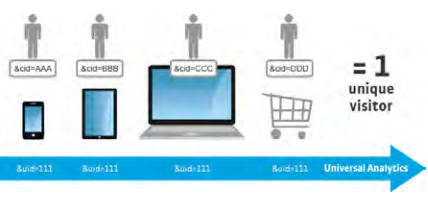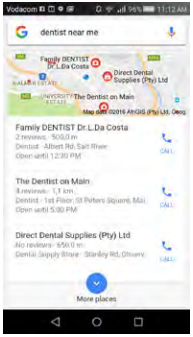7.3: Core principles
- Page ID
- 41677
Nine principles
Certain features are specific to certain mobile phones, and don’t apply to desktop or notebook computers or any other mobile devices. These features highlight the importance of mobile to marketers as a whole and affect the way both consumers and marketers create and share content.
Personal
Mobile phones are very personal devices. People don’t usually share their phones, so data attributed to a specific device can be attributed to a specific user. People also tend to keep their devices nearby, so they can offer valuable information about their location and great opportunities for location-based target marketing.
The implication for marketers: Since mobile phones are so personal, respect for privacy and permission is extremely important. Attributing data to a single user allows marketers to offer personalised interactions, communications, and experiences.
Always carried
Everyone is reluctant to leave their phone behind. Consider your own behaviour, what do you take with you when you leave your house? Your wallet, keys, and mobile phone? Various research has shown that smartphone owners in particular check their phone anywhere from every few minutes to at least once an hour and that people can spend up to 2.5 hours typing texts, swiping through apps or scrolling through Facebook (Gallup, 2015; Dscout, 2016).
The implication for marketers: The mobile device is present at every single step of the consumer journey, arguably the only channel that is. Messages sent to mobile phones are usually accessed within minutes of being received. Location services can also allow you to send contextual messages depending on the user’s real-time location.

Always on
The mobile phone is used to send and receive messages and phone calls. Messages and services can be sent and responded to at all times of the day.
The implication for marketers: This feature changes the services and messages that you can develop. Marketers need to be sensitive with their marketing communications; few people would enjoy a 4 a.m. SMS with a promotional offer. The flip side of this is that you can send time-sensitive offers, such as dinner messages just before work ends or a weekend coupon on a Friday afternoon.
Built-in payment system
This is one of the key features of the mobile phone, and a major source of mobile revenue. Every mobile phone has a built-in payment mechanism, the SIM card. Billing is easily handled through the user’s mobile network. NFC and QR codes allow other payment options.
A number of services, like Android Pay, Google Wallet, Snapscan or Zapper can turn the mobile into a virtual wallet or bank card, bringing banking and payment services to people globally. Apps like Uber have their own built-in payment services to make payment for users as easy as possible.

The implication for marketers: Consumers will pay for services and content on their mobile, which is enabled to make payments. This means that advertising is not the only way to generate revenue on mobile.
Available at the point of creative inspiration
Because the mobile phone is always close at hand, and many phones today offer tools such as cameras, videos, or note pads for jotting down ideas, it has become a permanent creative tool. It also makes access to social media very easy.
The implication for marketers: Users can be encouraged to interact with brands through campaigns created for mobile devices. Mobile is a useful tool in viral campaigns based on consumer-generated content. Because the amount of effort required to criticise or praise a brand on social is minimal, the social aspect of a mobile can be helpful or harmful or can be used to encourage social engagement or consumer feedback.
Accurate audience measurement
Every transaction made on a mobile phone can be uniquely tracked to that mobile phone number including voice calls, SMS, or Internet access. Mobile phones also allow for real-time tracking allowing you to edit campaigns as they are run. Google’s Universal Analytics also allows you to track user experience across devices.

The implication for marketers: The extra data gathered by mobile phones offers marketers profiling and segmenting opportunities for targeting the right audience. Because mobile phones are personal, measurement is improved overall. Campaigns can also be accurately measured and tracked for their return on investment (ROI) and the mobile phone offers many more ways to collect data, including location, web analytics, SMS response rates and Bluetooth.
Even with mobiles that are on a prepaid or pay-as-you-go contract, meaning that network operators do not have a name or demographic details to accompany the mobile number, you can still track and measure every transaction made by the user of a particular phone. This information is limited by networks, which determine the data they are willing to share with marketing companies.
Social context
Mobile can capture ‘the social context of our consumption’, which means capturing who we are sharing with. If you are using a product like an eBook, for instance, your mobile phone holds information on who you talked to while reading it, whom you shared it with, and whether you recommended it to a connection who then purchased the item (Ahonen, 2008).
The implication for marketers: Marketers can get insight from the way that mobile users share their products and socialise while using them and use this information to increase sales.
Augmented reality
The mobile phone makes it possible to add a layer of information to the real world through augmented reality (AR). For example, Layar, an augmented reality mobile browser, allows users to see embedded digital content in a number of sources such as posters, magazines, advertisements, or QR codes. This can lead to extra content such as movie trailers, discount codes and videos (Layar, 2016).
The implication for marketers: Cost and accessibility for this technology can sometimes be a concern, but adding a layer of interaction to the real world can be a powerful tool in a marketing campaign.
Digital interface
Various mobile technologies can enrich a user’s life by adding a digital layer to a real-world experience as with augmented reality. A mobile phone can also be used to control things in the real world, like switching on a light or opening a door.
The implication for marketers: Marketers can create memorable and emotive experiences that users will want to share and therefore broaden marketers’ reach. It also broadens the potential user interface options for a brand or product.
Location and mobile
Two of the most important contributions of mobile to the marketing world are location and convenience. If services and useful information can be shared based on a user’s location, the possibility for conversions naturally increase. The more contextually relevant your marketing message is to the user, the more likely they are to engage.
Research by Social Media Today showed that 88% of consumers who search for a local business on a mobile device call or visit that business within 24 hours, and seven out of 10 interact with their device while shopping in-store (Impact, 2016). Businesses should absolutely take advantage of the location-specific possibilities of mobile, making themselves easily findable online and ensuring a good mobile experience on their site.

Geolocation
Providing customers with what they really need becomes easier when combining marketing techniques with geolocation. For example, someone searching for a local business would find it very useful to see the closest one along with a map to its location. Google is well aware of this and will give users location-specific results, so it’s essential for a local business to list itself on Google Business.
Local news results can also offer a better user experience for people conducting news searches, and combining QR codes or short codes with print advertising is one way to provide consumers with geo-relevant information. A QR code on a poster could offer a discount voucher to someone coming to the local retail outlet, for example.
A business can also find new options to reach users by providing free wireless to users visiting its location, as Starbucks does.
To reach customers in areas of the world where data is scarce and more expensive, some online services turn to a ’zero rating’ system, which means that users don’t pay for data when accessing that particular service. While this is somewhat controversial, examples include Facebook Zero, and a carrier in the United States announced in 2016 that YouTube would be zero rated for its users, so video content for YouTube would not be counted against data caps (Brookings, 2016).
Some apps have stripped down user interfaces to use less data and work better with poor data connections and low-end phones. Examples here are Facebook Lite and YouTube Lite. These apps demonstrate an important lesson, that marketers need to tailor the mobile experience to their audience.
Mobile search combined with location awareness offers a targeted user experience. If a website can detect what device someone is using and where they are (which they can), they can deliver content customised to user location, either automatically or after user input.
Mobile social networks
Several social networks, like Instagram and Snapchat, have been created specifically for mobile phones, and the others focus heavily on a mobile-friendly user experience, since most people access social networks via mobile. For example, more than half of Facebook’s monthly active users access it only on mobile (VentureBeat, 2016).
Many social networks also encourage geotagging when users make or comment on posts so if you upload a photo to Facebook it will ask if you want to add a location. Networks like Foursquare encourage check ins at various locations by offering incentives like discounts or vouchers.
Consider the potential of social search as well. Product or brand searches based on social networks and location can be a powerful tool. Personal referrals are now combined with location-specific information.
Learn more about this in the Search engine optimisation chapter.
There is a strong strategic incentive to provide free Wi-Fi to customers at physical outlets like Starbucks mentioned above, as this not only provides a great selling point but also gives the marketer a channel to communicate with and gain information from customers. It lets you track their mobile behaviour and location (with permission, of course), send coupons and offers, engage in CRM-related questionnaires and provide helpful information and support.


